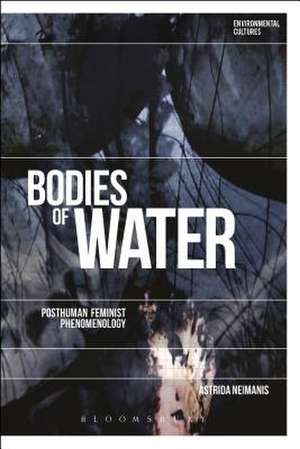Bodies of Water: Posthuman Feminist Phenomenology: Environmental Cultures
Autor Dr Astrida Neimanisen Limba Engleză Paperback – 29 mai 2019
| Toate formatele și edițiile | Preț | Express |
|---|---|---|
| Paperback (1) | 230.79 lei 3-5 săpt. | |
| Bloomsbury Publishing – 29 mai 2019 | 230.79 lei 3-5 săpt. | |
| Hardback (1) | 715.34 lei 6-8 săpt. | |
| Bloomsbury Publishing – 25 ian 2017 | 715.34 lei 6-8 săpt. |
Din seria Environmental Cultures
- 23%
 Preț: 197.05 lei
Preț: 197.05 lei - 23%
 Preț: 191.13 lei
Preț: 191.13 lei - 23%
 Preț: 197.34 lei
Preț: 197.34 lei - 30%
 Preț: 508.70 lei
Preț: 508.70 lei - 24%
 Preț: 196.36 lei
Preț: 196.36 lei - 7%
 Preț: 142.65 lei
Preț: 142.65 lei - 22%
 Preț: 128.11 lei
Preț: 128.11 lei - 30%
 Preț: 509.76 lei
Preț: 509.76 lei - 23%
 Preț: 190.68 lei
Preț: 190.68 lei - 30%
 Preț: 567.25 lei
Preț: 567.25 lei - 30%
 Preț: 569.06 lei
Preț: 569.06 lei - 22%
 Preț: 237.28 lei
Preț: 237.28 lei - 13%
 Preț: 230.03 lei
Preț: 230.03 lei - 23%
 Preț: 198.12 lei
Preț: 198.12 lei - 13%
 Preț: 229.24 lei
Preț: 229.24 lei - 23%
 Preț: 197.77 lei
Preț: 197.77 lei - 23%
 Preț: 198.05 lei
Preț: 198.05 lei - 24%
 Preț: 196.08 lei
Preț: 196.08 lei - 23%
 Preț: 198.82 lei
Preț: 198.82 lei - 30%
 Preț: 540.07 lei
Preț: 540.07 lei - 13%
 Preț: 238.58 lei
Preț: 238.58 lei - 30%
 Preț: 509.93 lei
Preț: 509.93 lei - 22%
 Preț: 225.59 lei
Preț: 225.59 lei - 23%
 Preț: 221.63 lei
Preț: 221.63 lei - 30%
 Preț: 773.81 lei
Preț: 773.81 lei - 22%
 Preț: 226.42 lei
Preț: 226.42 lei - 30%
 Preț: 509.93 lei
Preț: 509.93 lei - 22%
 Preț: 230.24 lei
Preț: 230.24 lei - 23%
 Preț: 255.76 lei
Preț: 255.76 lei - 13%
 Preț: 239.32 lei
Preț: 239.32 lei - 22%
 Preț: 237.28 lei
Preț: 237.28 lei
Preț: 230.79 lei
Preț vechi: 297.09 lei
-22% Nou
Puncte Express: 346
Preț estimativ în valută:
44.16€ • 46.02$ • 36.57£
44.16€ • 46.02$ • 36.57£
Carte disponibilă
Livrare economică 13-27 martie
Preluare comenzi: 021 569.72.76
Specificații
ISBN-13: 9781350112551
ISBN-10: 1350112550
Pagini: 248
Dimensiuni: 156 x 234 x 11 mm
Greutate: 0.35 kg
Editura: Bloomsbury Publishing
Colecția Bloomsbury Academic
Seria Environmental Cultures
Locul publicării:London, United Kingdom
ISBN-10: 1350112550
Pagini: 248
Dimensiuni: 156 x 234 x 11 mm
Greutate: 0.35 kg
Editura: Bloomsbury Publishing
Colecția Bloomsbury Academic
Seria Environmental Cultures
Locul publicării:London, United Kingdom
Caracteristici
Explores cultural attitudes to water to reimagine the relationship between human bodies and the natural world
Notă biografică
Astrida Neimanis is Lecturer in the Department of Gender and Cultural Studies at the University of Sydney, Australia. She is the co-editor of Thinking With Water (2013).
Cuprins
INTRODUCTION: Figuring Bodies of Water Bodies of Water (A Genealogy of a Figuration) Posthuman Feminism for the Anthropocene Living with the Problem Water is What We Make It The Possibility of Posthuman Phenomenology CHAPTER ONE: Embodying Water: Feminist Phenomenology for Posthuman Worlds A Posthuman Politics of Location Milky Ways: Tracing Posthuman Feminisms How to Think (About) a Body of Water: Posthuman Phenomenology Between Merleau-Ponty and Deleuze How to Think (As) a Body of Water: Access, Amplify, Describe! Posthuman Ties in a Too-Human World CHAPTER TWO: Posthuman Gestationality: Luce Irigaray and Water's Queer Repetitions Hydrological Cycles Elemental Bodies: Irigaray as Posthuman Phenomenologist? Love Letters to Watery Others: Marine Lover of Friedrich Nietzsche Gestationality as (Sexuate) Difference and Repetition The Onto-Logic of Amniotics (Queering Water's Repetitions) Bodies of Water Beyond Humanism CHAPTER THREE: Fishy Beginnings Other Evolutions Dissolving Origin Stories Carrier Bags and Hypersea Wet Sex Waters Remembered (Moving Below the Surface) Unknowability as Planetarity (Or, Becoming the Water that We Cannot Become) Aspiration, That Oceanic Feeling CHAPTER FOUR: Imagining Water in the Anthropocene Prologue / Kwe Swimming into the Anthropocene Learning from Anti-Colonial Waters Water is Life? Commodity, Charity and Other Repetitions Material Imaginaries and Other Aqueous Questions REFERENCES NOTES INDEX
Recenzii
For the last couple of decades, feminist theory has been immersed in a new materialist wave that has produced among the most innovative and capacious ways to think and to respond critically--ontologically, ethically, and politically--within the depths of the ongoing ecological crises. If hardly any field of philosophy, cultural studies, or science studies has been as well-equipped to think the posthuman turn as feminist approaches have, Astrida Neimanis's Bodies of Water brilliantly synthesizes, illustrates, and continues this feminist ebullition.
To read Astrida Neimanis's Bodies of Water is to immerse oneself in a fluid poetics, contemplating the teeming, virtual infinity of lifeforms for which water, in its myriad incarnations, supplies the medium of connection and dispersal; of gestation and differentiation through space-time. Through its feminist posthuman phenomenological lens, this work recasts the intertextual net eloquently and generously, re-inflecting a polyphony of feminist, philosophical, poetic, and scientific voices to address our planetary emergency in the wake of ecocidal extractionist and consumerist practices.
[Neimanis] does however, offer some important and somewhat revolutionary concepts to environmental educators and researchers in both her analysis of what she terms watery embodiment and in her intentional melding of posthu-man feminist theory with phenomenology. Neimanis is immediately frank about the reasons why embracing both of these concepts is crucial in these times, citing increasing Anthropocenic global water crises as an obvious instigator of the need to reconsider how we understand, and act on, the impact of our human bodies on our surrounding ecology.
To read Astrida Neimanis's Bodies of Water is to immerse oneself in a fluid poetics, contemplating the teeming, virtual infinity of lifeforms for which water, in its myriad incarnations, supplies the medium of connection and dispersal; of gestation and differentiation through space-time. Through its feminist posthuman phenomenological lens, this work recasts the intertextual net eloquently and generously, re-inflecting a polyphony of feminist, philosophical, poetic, and scientific voices to address our planetary emergency in the wake of ecocidal extractionist and consumerist practices.
[Neimanis] does however, offer some important and somewhat revolutionary concepts to environmental educators and researchers in both her analysis of what she terms watery embodiment and in her intentional melding of posthu-man feminist theory with phenomenology. Neimanis is immediately frank about the reasons why embracing both of these concepts is crucial in these times, citing increasing Anthropocenic global water crises as an obvious instigator of the need to reconsider how we understand, and act on, the impact of our human bodies on our surrounding ecology.











